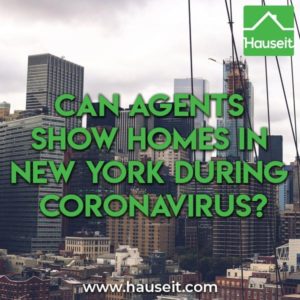No. Per additional guidance from the Real Estate Board of New York’s legal counsel, in-person showings by agents are absolutely not permitted while “Governor Cuomo’s Stay at Home Executive Order is still in place. Real estate licensees are expected to work from home.
Any licensed activity that a real estate licensee engages in which requires the real estate licensee to have in-person contact with others is not permissible under this executive order.”
With that said, per guidance from the New York State Association of Realtors (NYSAR), showings by FSBO sellers and by sellers under limited service listing arrangements are allowed, provided that the seller insists on showing the property directly to the buyer, and the listing agent only furnishes the necessary contact information for the seller to do so directly.
However, we cannot advise FSBO sellers and homeowners using a Flat Fee MLS listing to continue showing their homes during the pandemic as it violates the spirit of Governor Cuomo’s New York State on Pause executive order.
Keep in mind that Real Estate Board of New York (REBNY) members are predominately based in NYC, whereas NYSAR members are distributed throughout the rest of the state where population densities are less.
As a result, REBNY counsel necessarily will have a stricter interpretation of Governor Cuomo’s decrees vs NYSAR. Official guidelines regarding showings by licensees have been released by REBNY here.
Yes, per guidance issued by the New York State Department of Economic Development, real estate brokerage is an essential professional service with extensive restrictions:
While some brokers have interpreted this to mean that in-person showings can resume, this is certainly not the case as REBNY has clarified.

The New York State Association of Realtors backs up REBNY’s view by saying that licensees cannot have in-person contact with a member of the public and that:
Empire State Development (ESD) has issued guidance that “real estate services shall be conducted remotely for all transactions.” Licensees must utilize alternative methods of conducting business to avoid person to person contact with members of the public. NYSAR is unaware of any scenario where a licensee would be “legally necessary” to have in-person contact.
Pro Tip: REBNY legal counsel believes that many real estate brokers have misinterpreted the government’s guidance on allowing “virtual showings” to mean that they can travel to a property and host a video-conference at the property. REBNY believes the more conservative view that follows the spirit of Governor Cuomo’s executive order is to not travel unnecessarily at all, especially in dense urban areas like NYC, as every time you leave your home you put others at risk. The NY Department of State has already received many complaints against real estate agents for failing to comply with Governor Cuomo’s decrees.
A Full Service Listing for 1%
Sell your home with a traditional full service listing for just one percent commission.
Yes. The guidance from Empire State Development only applies to businesses and not members of the public. Per the New York State Association of Realtors COVID-19 FAQ Page:
NYSAR recommends that licensees should not be involved in coordinating an unaccompanied showing. If the seller demands that buyer’s be permitted to view the property the licensee should not be involved in the process. If the seller instructs the listing agent to provide their contact information to the buyer, then the listing agent should do so. This should be the only activity the listing agent performs. The listing agent should not be coordinating anything between the seller and buyer except for providing contact information.
The guidance from ESD only applies to businesses and nothing prevents members of the public from having in person contact so long as they maintain recommended health and safety measures. So nothing prevents a seller from permitting a buyer into their home as that is their choice much like they can under a FSBO or limited service listing. Since such activities are permitted among members of the general public, a licensee providing the phone number is not acting contrary to the ESD guidance. The licensee is merely following the direction of their principle under their fiduciary duties. The licensee should advise the seller that all recommended health and safety procedures should be followed.
This means traditional For Sale By Owner sellers are not restricted from interacting with members of the public, i.e. showing their property.
In the case of an Assisted FSBO listing, where a seller pays a flat fee for an agent to list his or her property on the MLS, an agent must abide by his or her fiduciary duty to the client and dutifully hand over contact information of the buyer if the seller insists on continuing to show the property by owner.
Keep in mind that open houses are still prohibited, and many public search websites will not allow the posting of open houses anyway during the pandemic.
If you are a FSBO seller or an Assisted FSBO seller and you still choose to allow carefully vetted buyers to view your property via private showings, then we recommend reviewing the following safety procedures:
-
Check the CDC, NYS and NYC websites for the latest updates and guidelines.
-
Social distancing: Consider conducting meetings and events via phone or video conference.
-
Sanitation: Clean and disinfect all frequently touched objects and surfaces, per CDC recommendations.
-
Hygiene: Wash your hands frequently with soap and water. If not available, use hand sanitizer with alcohol.
-
Request buyers to wear PPE such as a face mask or latex gloves and to avoid touching anything as much as possible.
-
Request buyers to wear disposable “booties” over their shoes before entering your property.
-
If you, the buyer or a member of either party’s household is ill, stay home and avoid physical contact with others.
-
Seek help: Call the NYS Novel Coronavirus hotline if you suspect exposure (1-888-364-3065).
-
Present the COVID Disclosure Form to anyone before they enter your home.






Thought I’d share what we received from our managing agent, given that NYC has finally started to re-open, starting with Phase 1 as of Monday.
Phase 1 Re-opening of NYC June 8th, 2020
Today is the first day of Phase 1 in New York City. This only allows non-essential construction, as well as manufacturing and curb-side retail to commence operations. The following update addresses general guidelines and procedures for such operations to commence. Not every guideline is applicable to every building. These are only the city and state’s criteria for when and what work can take place at this time. Ultimately, a Board has the final authority on whether any building project, alteration or other construction work may proceed.
CONSTRUCTION GUIDELINES:
NYC Department of Buildings and Department of Health & Mental Hygiene have issued a joint guideline for how work will be allowed to progress at a building. These include the following criteria:
• Ensure 6 feet of distance between personnel, unless safety or core function of the work activity requires a shorter distance.
• All personnel and visitors to construction sites must wear face coverings appropriate for their task, unless medically unable to do so.
• Tightly confined spaces (e.g., elevators, hoists) occupied by 50% maximum allowed number of people. – 50% capacity must be posted within the cab AND at each landing. (Note this capacity limit is in conflict with NY State limit of one employee per car).
• A site safety monitor must be designated whose responsibilities include continuous compliance with all aspects of the site safety plan.
• Appropriate signage is posted throughout the site to remind personnel to adhere to proper hand hygiene, physical distancing rules, appropriate use of personal protective equipment, and cleaning and disinfecting protocols.
• Safety plan(s) specific to each GC and job are conspicuously posted on site and include a copy of the submitted State affirmation.
• A communication plan for employees, visitors, and clients is available at the site.
• A continuous log of every person who may have had close contact with other individuals at the work site or area is kept at the site.
• There are hand hygiene stations available on site and readily accessible to workers.
• A cleaning and disinfection log is present at the site with minimum daily entries.
In the first 30-days of construction resumption DOB will be monitoring with a focus on education and implementation. Thereafter, non-compliance with result in Stop-Work orders, summonses and fines of up to $5,000 per offense.
In addition to these guidelines, the governor has also issued and executive order providing building owners with the discretion to require individuals entering a building to undergo a temperature check and may deny entry access to anyone refusing to submit to a temperature check or to someone with a temperature above 100.4 degrees F.
Once a building has met the threshold of these criteria and has made a decision allowing construction to progress, a number of other considerations need to be addressed. These include the following:
• Obtaining new permits (where necessary) for all work. It has been 100-days since work was suspended with many permits lapsing in the interim.
• Obtaining updated insurance from all contractors. Over the shutdown period policies may have lapsed and/or contractors may have willingly suspended policies. In most cases, the lapsed insurance would require issuance of a new permit as well.
• Setting up a schedule with super and/or management before any work may commence.to mesh all of the guidelines with job requirements and building logistics.
• Copy of affirmation submitted by contractor to the State.
Boards may also elect to implement other criteria as part of allowing work to commence in building:
• Setting strict days and start/end times when work can take place.
• PPE must be put on before entering building and remain on until leaving.
• Place a limit on the number of employees allowed in a unit at any time.
• Where applicable using only a freight/service entrance/elevator for entering and exiting. Workers are not to transit in and out with building residents. This should be done one employee at a time.
• Cordoning off work area.
• Only one person should be designated to act as a runner for retrieving food and other items.
• Building staff should be contacted for accessing freight elevator to enter or leave. If occupied, workers must wait for the car to return empty.
Conditions as a result of the Phase 1 reopening are being monitored closely by bother the City and the State. Any results identifying spikes in cases during the restart will be assessed in will most likely result in roll-backs from a Phase or delay in implementing the next phase. As a reminder the Phases are broken down as follows are to commence sequentially in two-week increments:
1. Phase 1 – Non-emergency construction, manufacturing and select retail (non-entry).
2. Phase 2 – Medical and professional offices, financial/insurance offices, brokerage and general retail.
3. Phase 3 – Restaurants, hotels and other related services.
4. Phase 4 – Education, entertainment, sports, arts and recreation.